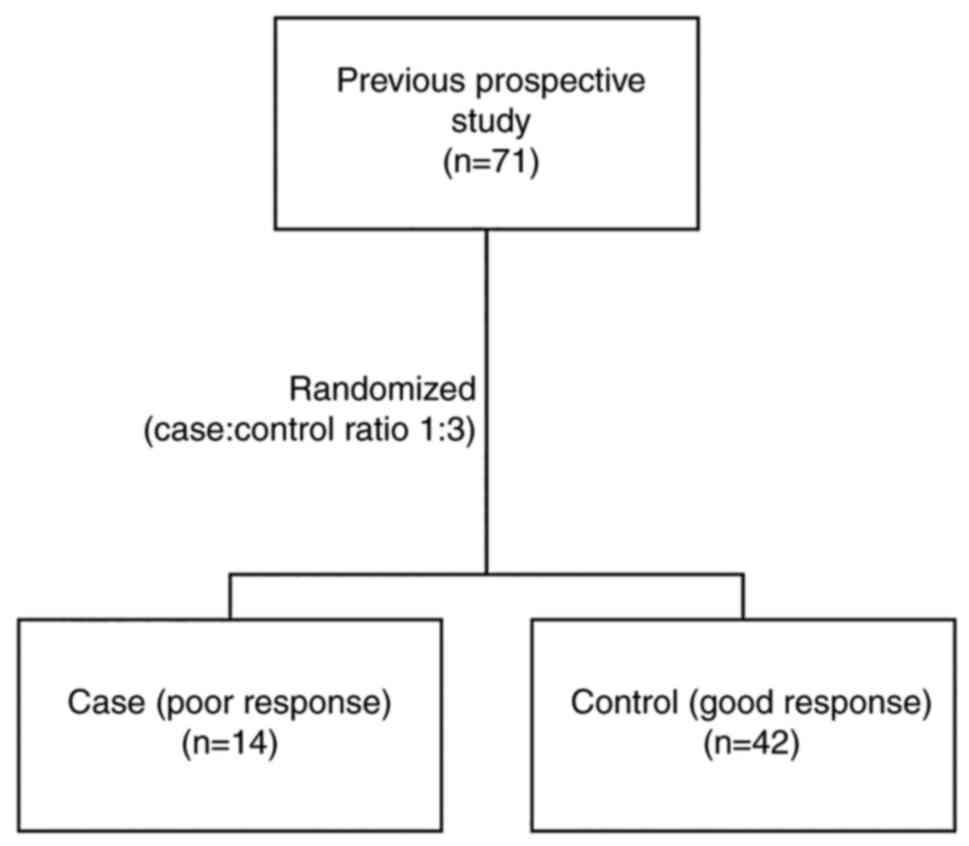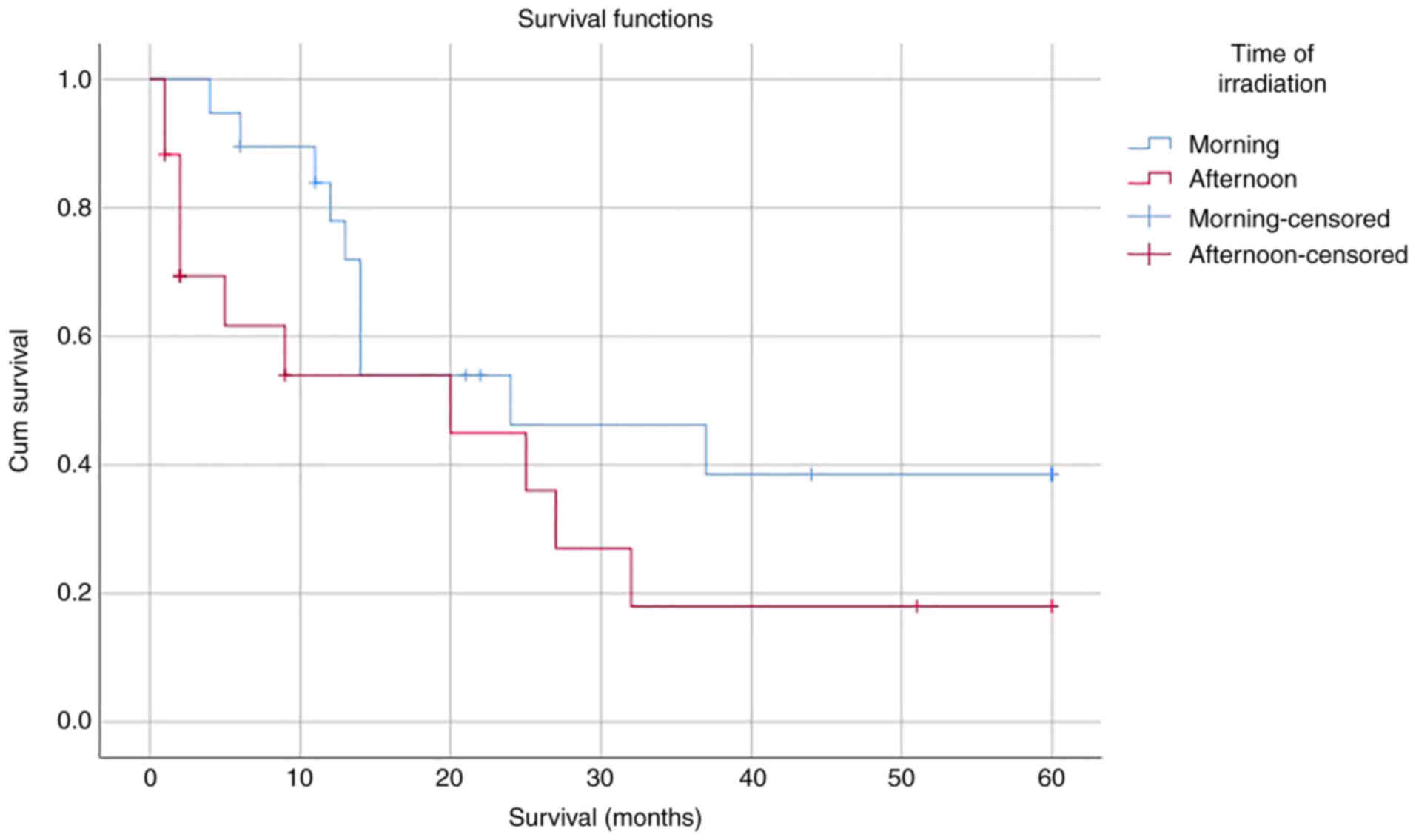|
1
|
Sung H, Ferlay J, Siegel RL, Laversanne M,
Soerjomataram I, Jemal A and Bray F: Global cancer statistics 2020:
GLOBOCAN estimates of incidence and mortality worldwide for 36
cancers in 185 countries. CA Cancer J Clin. 71:209–249. 2021.
View Article : Google Scholar : PubMed/NCBI
|
|
2
|
Hull R, Mbele M, Makhafola T, Hicks C,
Wang SM, Reis RM, Mehrotra R, Mkhize-Kwitshana Z, Kibiki G, Bates
DO and Dlamini Z: Cervical cancer in low and middle-income
countries. Oncol Lett. 20:2058–2074. 2020. View Article : Google Scholar : PubMed/NCBI
|
|
3
|
Wahidin M, Febrianti R and Susanty F:
Burden of cervical cancer in Indonesia: Findings from the global
burden of disease study 1990–2017. Proceedings of the 4th
International Symposium on Health Research. Atlantis Press; Bali:
2020
|
|
4
|
Pearcey R, Brundage M, Drouin P, Jeffrey
J, Johnston D, Lukka H, MacLean G, Souhami L, Stuart G and Tu D:
Phase III trial comparing radical radiotherapy with and without
cisplatin chemotherapy in patients with advanced squamous cell
cancer of the cervix. J Clin Oncol. 20:966–972. 2002. View Article : Google Scholar : PubMed/NCBI
|
|
5
|
Cohen PA, Jhingran A, Oaknin A and Denny
L: Cervical cancer. Lancet. 393:169–182. 2019. View Article : Google Scholar : PubMed/NCBI
|
|
6
|
Joiner M and van der Kogel A: Basic
Clinical Radiobiology. 4th edition. Hodder Arnold; London: pp.
p3752009
|
|
7
|
Ramli I: Influence of radiation patterns
following circadian rhythm upon response of radiotherapy of uterine
cervix cancer: Melatonin and cycle cell phase as biological marker
and radiosensitivity (unpublished dissertation). Universitas
Indonesia. (Jakarta). 2019.
|
|
8
|
Bjarnason GA, Jordan RC, Wood PA, Li Q,
Lincoln DW, Sothern RB, Hrushesky WJ and Ben-David Y: Circadian
expression of clock genes in human oral mucosa and skin:
Association with specific cell-cycle phases. Am J Pathol.
158:1793–1801. 2001. View Article : Google Scholar : PubMed/NCBI
|
|
9
|
Wood PA, Du-Quiton J, You S and Hrushesky
WJ: Circadian clock coordinates cancer cell cycle progression,
thymidylate synthase, and 5-fluorouracil therapeutic index. Mol
Cancer Ther. 5:2023–2033. 2006. View Article : Google Scholar : PubMed/NCBI
|
|
10
|
Nagoshi E, Saini C, Bauer C, Laroche T,
Naef F and Schibler U: Circadian gene expression in individual
fibroblasts. Cell. 119:693–705. 2004. View Article : Google Scholar : PubMed/NCBI
|
|
11
|
Warman GR, Tripp HM, Warman VL and Arendt
J: Circadian neuroendocrine physiology and electromagnetic field
studies: Precautions and complexities. Radiat Prot Dosimetry.
106:369–373. 2003. View Article : Google Scholar : PubMed/NCBI
|
|
12
|
Arjona A and Sarkar DK: Circadian
oscillations of clock genes, cytolytic factors, and cytokines in
rat NK cells. J Immunol. 174:7618–7624. 2005. View Article : Google Scholar : PubMed/NCBI
|
|
13
|
Granda TG, Liu XH, Smaaland R, Cermakian
N, Filipski E, Sassone-Corsi P and Lévi F: Circadian regulation of
cell cycle and apoptosis proteins in mouse bone marrow and tumor.
FASEB J. 19:304–306. 2005. View Article : Google Scholar : PubMed/NCBI
|
|
14
|
Lis CG, Grutsch JF, Wood P, You M, Rich I
and Hrushesky WJ: Circadian timing in cancer treatment: The
biological foundation for an integrative approach. Integr Cancer
Ther. 19:1–22. 2003.
|
|
15
|
Karbownik M and Reiter RJ: Melatonin
protects against oxidative stress caused by delta-aminolevulinic
acid: Implications for cancer reduction. Cancer Invest. 20:276–286.
2002. View Article : Google Scholar : PubMed/NCBI
|
|
16
|
Therasse P, Arbuck SG, Eisenhauer EA,
Wanders J, Kaplan RS, Rubinstein L, Verweij J, Glabbeke MV, van
Oosterom AT, Christian MC, et al: New guidelines to evaluate the
response to treatment in solid tumors. J Natl Cancer Inst.
92:205–216. 2000. View Article : Google Scholar : PubMed/NCBI
|
|
17
|
Biesheuvel CJ, Vergouwe Y, Oudega R, Hoes
AW, Grobbee DE and Moons KG: Advantages of the nested case-control
design in diagnostic research. BMC Med Res Methodol. 8:482008.
View Article : Google Scholar : PubMed/NCBI
|
|
18
|
Langholz B and Clayton D: Sampling
strategies in nested case-control studies. Environ Health Perspect.
102 (Suppl 8):47–51. 1994. View Article : Google Scholar : PubMed/NCBI
|
|
19
|
Kennaway DJ: Measuring melatonin by
immunoassay. J Pineal Res. 69:e126572020. View Article : Google Scholar : PubMed/NCBI
|
|
20
|
Hunt T and Sassone-Corsi P: Riding tandem:
Circadian clocks and the cell cycle. Cell. 129:461–464. 2007.
View Article : Google Scholar : PubMed/NCBI
|
|
21
|
Peyric E, Moore HA and Whitmore D:
Circadian clock regulation of the cell cycle in the zebrafish
intestine. PLoS One. 8:e732092013. View Article : Google Scholar : PubMed/NCBI
|
|
22
|
Klevecz RR, Shymko RM, Blumenfeld D and
Braly PS: Circadian gating of S phase in human ovarian cancer.
Cancer Res. 47:6267–6271. 1987.PubMed/NCBI
|
|
23
|
Lakatua DJ, White M, Sackett-Lundeen LL
and Haus E: Change in phase relations of circadian rhythms in cell
proliferation induced by time-limited feeding in BALB/c X DBA/2F1
mice bearing a transplantable Harding-Passey tumor. Cancer Res.
43:4068–4072. 1983.PubMed/NCBI
|
|
24
|
Smaaland R, Lote K, Sothern RB and Laerum
OD: DNA synthesis and ploidy in non-Hodgkin's lymphomas demonstrate
intrapatient variation depending on circadian stage of cell
sampling. Cancer Res. 53:3129–3138. 1993.PubMed/NCBI
|
|
25
|
Florez JC and Takahashi JS: Biological
rhythm and the pineal gland. Greger R and Windhorst U:
Comprehensive human physiology: From cellular mechanisms to
integration Berlin, Heidelberg: Springer; 1996, pp. 1199–1214.
View Article : Google Scholar
|
|
26
|
Arendt J: Melatonin and the pineal gland:
Influence on mammalian seasonal and circadian physiology. Rev
Reprod. 3:13–22. 1988. View Article : Google Scholar : PubMed/NCBI
|
|
27
|
Jung B and Ahmad N: Melatonin in cancer
management: Progress and promise. Cancer Res. 66:9789–9793. 2006.
View Article : Google Scholar : PubMed/NCBI
|
|
28
|
Srinivasan V, Spence DW, Pandi-Perumal SR,
Trakht I and Cardinali DP: Therapeutic actions of melatonin in
cancer: Possible mechanisms. Integr Cancer Ther. 7:189–203. 2008.
View Article : Google Scholar : PubMed/NCBI
|
|
29
|
Aulinas A: Physiology of the pineal gland
and melatonin. Feingold KR, Anawalt B, Boyce A, Chrousos G, de
Herder WW, Dhatariya K, et al: Endotext (Internet) South Dartmouth
(MA): MDText.com, Inc.; 2000, (cited 2022 Jul 26). Available from:.
http://www.ncbi.nlm.nih.gov/books/NBK550972/
|
|
30
|
Brzezinski A: Melatonin in humans. N Engl
J Med. 336:186–195. 1997. View Article : Google Scholar : PubMed/NCBI
|
|
31
|
Karasek M and Winczyk K: Melatonin in
humans. J Physiol Pharmacol. 57 (Suppl 5):19–39. 2006.PubMed/NCBI
|
|
32
|
Martín V, Herrera F, Carrera-Gonzalez P,
García-Santos G, Antolín I, Rodriguez-Blanco J and Rodriguez C:
Intracellular signaling pathways involved in the cell growth
inhibition of glioma cells by melatonin. Cancer Res. 66:1081–1088.
2006. View Article : Google Scholar : PubMed/NCBI
|
|
33
|
Vijayalaxmi, Thomas CR Jr, Reiter RJ and
Herman TS: Melatonin: From basic research to cancer treatment
clinics. J Clin Oncol. 20:2575–2601. 2002. View Article : Google Scholar : PubMed/NCBI
|
|
34
|
Blask DE and Hill SM: Effects of melatonin
on cancer: Studies on MCF-7 human breast cancer cells in culture. J
Neural Transm Suppl. 21:433–449. 1986.PubMed/NCBI
|
|
35
|
Hill SM and Blask DE: Effects of the
pineal hormone melatonin on the proliferation and morphological
characteristics of human breast cancer cells (MCF-7) in culture.
Cancer Res. 48:6121–6126. 1988.PubMed/NCBI
|
|
36
|
Sánchez-Hidalgo M, Guerrero JM, Villegas
I, Packham G and de la Lastra CA: Melatonin, a natural programmed
cell death inducer in cancer. Curr Med Chem. 19:3805–3821. 2012.
View Article : Google Scholar : PubMed/NCBI
|
|
37
|
Lee DW, Kim YT, Kim JH, Kim S, Kim SW, Nam
EJ and Kim JW: Clinical significance of tumor volume and lymph node
involvement assessed by MRI in stage IIB cervical cancer patients
treated with concurrent chemoradiation therapy. J Gynecol Oncol.
21:18–23. 2010. View Article : Google Scholar : PubMed/NCBI
|
|
38
|
Feldman J, Goldwasser R, Mark S and
Schwartz J: A mathematical model for tumor volume evaluation using
two dimensions. J Appl Quant Methods. 4:455–462. 2008.
|
|
39
|
Mayr NA, Taoka T, Yuh WT, Denning LM, Zhen
WK, Paulino AC, Gaston RC, Sorosky JI, Meeks SL, Walker JL, et al:
Method and timing of tumor volume measurement for outcome
prediction in cervical cancer using magnetic resonance imaging. Int
J Radiat. 52:14–22. 2002. View Article : Google Scholar : PubMed/NCBI
|
|
40
|
Nicolaides NC, Charmandari E, Chrousos GP
and Kino T: Circadian endocrine rhythms: The
hypothalamic-pituitary-adrenal axis and its actions. Ann NY Acad
Sci. 1318:71–80. 2014. View Article : Google Scholar : PubMed/NCBI
|
















